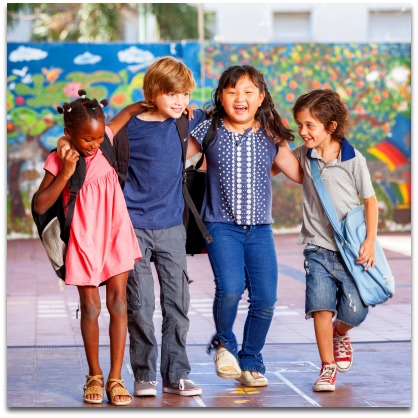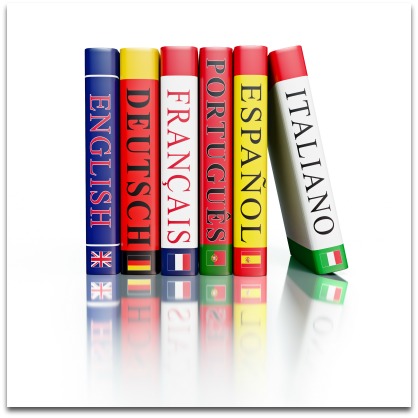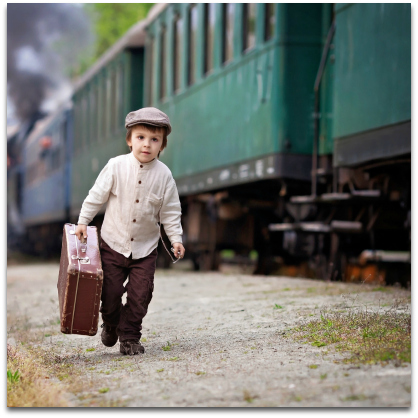 As someone who has studied and worked in several foreign countries, I know firsthand how challenging it can be to immerse yourself in another culture.
As someone who has studied and worked in several foreign countries, I know firsthand how challenging it can be to immerse yourself in another culture.
I will never forget the first evening I spent with my host family when I was a Peace Corps Volunteer in Uzbekistan. I didn’t know what to expect or how to act, and I couldn’t communicate more than my most basic needs in the local language.
My host family and I sat at the dinner table, making gestures and laughing awkwardly. It was terrifying and uncomfortable.
Fortunately, persevering through the challenges of intercultural exchange can bring enormous rewards. By the time I left Uzbekistan, my host family and I had become very close, I had learned a new language, and I had a whole new perspective on the world.
When my husband (who was also a Peace Corps Volunteer) and I had children, we made a commitment to expose our kids to intercultural experiences so they could learn to be more open-minded, compassionate, and empathetic.
We feel strongly that it’s important to teach our kids to respect other cultures and be comfortable with people different from themselves.
Although we love to travel abroad, it’s not always possible. Job schedules, commitments to extended family members, and limited time and money can make it difficult or even impossible.
The good news is that you don’t need a lot of time or money – and you don’t need to travel or live abroad – in order to teach your kids to be more open-minded, accepting, and compassionate. Your family can experience the joys and lessons of intercultural exchange without leaving your hometown!
But First, Why Learn to Be Multicultural?
It’s cliché, but it’s true: the world is getting smaller. We live in an increasingly multicultural, international world. In order to even walk down the street, it’s important to know that there are people who are culturally different from ourselves.
By introducing your kids to other cultures and different ways of viewing the world, you can provide them with skills and outlooks that will benefit them for the rest of their lives. Research has found that people with multicultural experience are more creative. They make better teachers and are more likely to get promotions at work.
The ability to speak another language or simply be comfortable interacting with people from a wide range of different backgrounds is an asset many employers seek when hiring. A recent study found that 93 percent of employers wanted to recruit employees with the ability to work on international teams!
More importantly, exposure to other cultures and worldviews can make kids more open-minded, compassionate, and understanding. If you’re like me, you want more than anything for your children to grow up to be good, kind, happy people. It turns out exposing them to cultures and people who are different from themselves is essential to achieving this most important goal!
It can also be a lot of fun!
Getting Started
 If you haven’t traveled or been exposed to many other cultures, this might seem daunting. I want to assure you that it isn’t. The first step is simply to recognize that it’s important to teach kids about other ways of life and that it’s something you want to do.
If you haven’t traveled or been exposed to many other cultures, this might seem daunting. I want to assure you that it isn’t. The first step is simply to recognize that it’s important to teach kids about other ways of life and that it’s something you want to do.
After that, there are many different options you have. Start by looking around you. There are probably many opportunities for multicultural learning that you may have overlooked.
Even if you live surrounded by people from all over the world, it’s surprisingly easy to stay within your comfort zone – your private safety bubble. But once you acknowledge that you want to do more to step outside that bubble, you’ll find many opportunities to do so.
Read About It
There are so many fantastic books that can introduce you and your kids to other cultures!
Visit your library and ask the librarians for suggestions. Libraries often make a point of having books that introduce kids to differences, so you won’t have trouble finding books.
Some libraries also have story-time or circle-time programs in foreign languages. My local library offers a weekly one-hour program in Spanish and in French. It’s an hour of fun and games and attracts native Spanish/French speakers as well as attendees with no knowledge of those languages.
Non-fiction books are a great way to learn about different places, customs, traditions and belief systems. A good place to start is to check out these books:
• National Geographic offers a wide range of world atlases for young kids up to adults. These offer factual insights and pictures from around the world.
• Hungry Planet: What the World Eats is a fascinating pictorial exploration of the foods eaten by families in different countries around the world.
• 14 Cows for America is an inspiring picture book about a young man who returned from the United States to his home in Kenya after the September 11 attacks. The generous gift he and his people gave to the American people emerges as a sign of hope and friendship after this tragic event.
Fiction books are an excellent way to delve into the feelings and lifestyles of people who live in other places, speak different languages, and have different beliefs and customs. Fiction books are particularly good at holding the attention of young children and offer a great opportunity to teach empathy. A few to consider include:
• Ten Tiny Babies is a board book ideal for even the youngest of babies. Although it doesn’t directly discuss other cultures, it illustrates the differences in how different babies can look.
• The Tale of the Firebird is a picture book for older children (ages 4-8) that takes them on a fantastical journey with Ivan Tsarevich, who goes in search of a beautiful firebird.
• Bronze and Sunflower is a heartwarming novel (aimed at kids 10 and older) about a young city girl who moves to the countryside during the Chinese Cultural Revolution. She meets a boy who is unable to speak, and the two become friends.
There are endless possibilities. This list of books from the New York Public Library and this list of international books for teens are great places to get started.
Movies and Documentaries
Just like there are books that introduce kids to other parts of the world and cultures, there are many movies, documentaries, television series, and even homemade online videos to explore.
Non-fiction travel shows like Rick Steve’s series offer glimpses into the life and sights of foreign countries. Meanwhile, movies offer journeys into the lives of kids in other parts of the world.
The Red Balloon from France is a classic children’s favorite about a young boy who finds a balloon. The world of animated films from Japan is expansive, ranging from kid-appropriate films like My Neighbor Totoro to films for teens and adults. Review online list of foreign films for kids to get more ideas.
There are also opportunities to explore children’s TV series from other countries. One of my older son’s favorite shows when he was little was a Russian cartoon called Masha i Medved (Masha and the Bear). Although most episodes are in Russian, there is minimal talking, and most are easy to understand without translation.
Taste the World
 Food is a great way to introduce kids to other cultures and get them excited about trying new things. What’s great about different cuisines is that they can reveal the commonalities between us – we all love good flavors!
Food is a great way to introduce kids to other cultures and get them excited about trying new things. What’s great about different cuisines is that they can reveal the commonalities between us – we all love good flavors!
But they can also showcase the diversity in tastes, ingredients, and methods of eating.
You can experience international food by visiting local restaurants. Chances are you can find a Chinese or Mexican restaurant nearby. If you’re lucky, you live in a place that offers an even wider variety of dining options and gives you opportunities to try things like Indian, Vietnamese, Central American, Thai, German, Middle Eastern, Ethiopian, and more!
When you visit a restaurant that serves a cuisine different from the one you’re used to, talk with your server or the restaurant owners to learn more about the food and their culture. Ask for recommendations on what to order and be willing to step out of your comfort zone.
You can also cook food from different cuisines at home. If you live in a place with international grocery stores or ethnic markets, these can be a lot of fun to visit with your kids. You can browse fruits and vegetables you might never have seen before, buy sweet treats that are popular in other countries, and get ingredients to experiment with.
A plethora of cookbooks will help you cook new foods and learn about other cultures in the process. This is one of my favorite activities not only because I love to eat, but because it’s an active way for kids to be involved and try something new. Here are a few books to get you started:
• Around the World in 80 Purees: Easy Recipes for Global Baby Food is a fun way to experiment with food for babies.
• Kids’ cookbooks like The World in My Kitchen and The International Cookbook for Kids are tailor-made for young people and provide recipes for dishes that are likely to be kid-friendly.
• As you get more adventurous or discover an affinity for a particular cuisine, delve deeper with cookbooks from specific places, like Turkish Delights, Eat Real Vietnamese Food, and The South African Illustrated Cookbook.
• Kids love desserts, so a great way to win over a stubborn cooperator is to explore sweet recipes. Baklava to Tarte Tatin: A World Tour in 110 Dessert Recipes is a fun option. There are also country-specific dessert books like My Sweet Mexico, which provides stories and pictures to go along with the desserts.
Get Involved
Seek out opportunities to get involved with local organizations focused on different cultures or places. There are a wide range of organizations that offer programs or volunteer opportunities.
Sister City Programs can be a great resource for volunteering and learning more about another place – as well as hosting visitors and possibly traveling abroad yourself. They often host cultural events and celebrations on holidays and may offer pen pal programs.
Other cultural organizations and places of worship also offer festivals and celebrations that are open to the public. Look for opportunities to celebrate holidays and other cultural traditions that may be different from your own. These events are usually kid-friendly and offer opportunities to hear beautiful music and taste delicious food from other parts of the world.
You might also seek out volunteer opportunities with organizations that assist immigrants and refugees. You and your family could volunteer to be a conversation partner for someone learning your language. You could also provide rides and other logistical assistance to families as they settle into a new place.
Take Classes/Study a Language
 Learning a foreign language is easier as a child, so providing your kids with opportunities to study another language at a young age is a gift.
Learning a foreign language is easier as a child, so providing your kids with opportunities to study another language at a young age is a gift.
Most schools begin to offer language classes in middle school or high school, but you may find earlier opportunities in your town or city. If you’re really lucky, you might live in a city that offers an immersion or dual-language program at your public elementary school.
There may also be parent-and-child classes for babies and toddlers in other languages, or after-school for language study. You can also look for language-study camps that provide short-term or longer-term immersion opportunities.
Host an Exchange Student
One of the best ways to help your kids learn about cultural differences is to literally bring the experience home with you. Hosting an exchange student or au pair is an opportunity to create a very special bond with someone from another part of the world while teaching your kids empathy, understanding, and flexibility.
The most common opportunities are to host a high school student for an academic year or to participate in a yearlong au pair program. But if a year seems too daunting, there are also shorter-term opportunities.
Some programs look for families to host students for just a few weeks or over the summer. Other programs seek out host families for international college students who live on campus most of the time and visit host families on weekends or holidays. Still others look for hosts who can welcome a student or international scholar into their home for just a weekend or an evening.
My family has hosted visiting college-level scholars for dinners at our home and has hosted high-school students for three-week periods over the summer. Both were great experiences and opened our eyes to other cultures.
The visitors we hosted enjoyed the opportunity to interact with our young kids and see what family life is like in the U.S., while our kids loved having visitors to play and talk with.
Contact local schools or colleges in your town, as well as international education programs, and find out what opportunities there are to bring the world into your home and experience the endless benefits!
Study Abroad
As your kids get older, seek out opportunities for them to study abroad themselves. By living abroad, studying in a foreign school and possibly learning a new language, your kids will have the ultimate multicultural learning opportunity – and likely will develop lifelong skills and friendships in the process.
There are a variety of programs that offer study-abroad opportunities for high school students, ranging from short-term service trips and language-learning opportunities to summer and academic-year programs. Some require you to pay, while others have a competitive admissions process and provide the free opportunities through scholarships.
After high school, continue to think globally. There are many study-abroad programs at colleges and universities, as well as opportunities to attend international colleges full-time – sometimes at a reduced price tag compared to your home country!
Travel
 Although the logistics of traveling with kids can be a hassle, the benefits of fully immersing yourself in another culture are well worth the minor irritation.
Although the logistics of traveling with kids can be a hassle, the benefits of fully immersing yourself in another culture are well worth the minor irritation.
Travel is fun, educational, and invigorating. It can make you happier and even improve your mental health!
When you’re surrounded by the sights, scents, and sounds of a different culture for several days, you and your children can delve more deeply into intercultural exchange. You are forced to confront the differences you experience and rethink the way you look at the world.
Kids in particular can benefit from travel because it provides explicit opportunities for noticing differences. When you’re immersed in another culture, you quickly see that not everyone lives the way you do or has the same beliefs, goals, and ideas.
One of my favorite parts of travel is the opportunity to notice small but telling differences in habit. When you least expect it, you’re confronted with something completely different than “normal.”
Maybe you run a quick errand to buy a bottle of shampoo and notice that the people waiting to make purchases don’t line up the way they do in your home country. Or maybe you step onto a bus or tram and find that people are more or less likely to give up their seats (to a woman, senior, or person with disabilities, for example).
These are small differences but can provide insights into what local people value, as well as give you a chance to rethink the way you do things at home.
Be sure to maintain a positive outlook and refrain from being critical of the differences you see. Model respect for the local culture, and encourage your children to consider the pros and cons of both the local way of doing things and their own.
Remember that your goal is to encourage your kids to learn to be more open-minded and accepting. The more time you spend outside the “tourist areas,” the more opportunities you’ll have to delve deeply into the local culture and expose your kids to a different way of life.
The 2-Minute Action Plan for Fine Parents
After reading this, I hope you’re as excited about introducing your kids to other cultures as I am!
The best way to get started is to visit your library and check out some books that will pique your and your children’s curiosity. Then build on that to explore further – find more books, watch videos, try some new types of food!
Start seeking out new parts of your town or region to visit, and look for festivals or other events you can attend. Remember that there are likely a variety of different cultures within your home country, so traveling abroad is not necessary to experience different cultures. You can experience and learn about different ways of life without going far at all!
The Ongoing Action Plan for Fine Parents
As you and your kids get more comfortable experiencing other cultures, seek out language classes for them and for you (language-learning is fun!). Research hosting opportunities and talk with your family about whether you’re ready to welcome an exchange student or other international visitor into your home.
If you’re feeling really motivated, consider whether it’s possible to relocate to another country for a few years! This is my favorite way to experience another culture because it provides opportunities to truly immerse yourself into another culture and experience it every day.
Most important: make a point to incorporate regular multicultural experiences into your life, and model open-mindedness and excitement about differences for you kids.
Talk with people you don’t normally talk with, try new foods, and visit parts of town you hadn’t thought to visit before. You’ll soon find that this isn’t “work” but that it makes you and your family happier, more open-minded, and surrounded by more friends!
This is so true! Hosting an au pair is a fantastic way to expose your family to other cultures (plus, affordable childcare is never a downside). When we signed up to host with Go Au Pair, I never imagined the thousand little things I’d discover about Colombia from our au pair, Adriana. The more I learn, the more fascinated I become. It’s also becoming increasingly clear to me how little I truly learned about other cultures growing up.
My kids are already learning Spanish, and they eat Colombian food daily, which amazes me. The first time I ever ate truly foreign food was when I studied abroad during college (which cost an arm and a leg), and I didn’t start learning another language until Jr. High.
I love knowing that not only is our family getting this great cultural exchange experience, but we’re also helping someone study abroad for a year. The au pair program is so much more affordable for young adults than trying to work to cover rent and tuition. Adriana has the funds & the ability to travel because of this program. (Makes me wish I’d done this when I was younger! If only I’d known about it!)
Seriously, if you have 2 or more kids who need childcare, and a private bedroom an au pair could use, consider this program. I could go on for days about the benefits of not having to get my kids ready in the morning, having someone give extra attention to reading, having more one-on-one attention, having a little more help around the house with cleaning up after the kids… but overall, we’re just happier as a family.
It sounds like a great experience! I have a number of friends who have had au pairs and also say great things about their experiences. One couple I know goes out for date nights more now that they have an au pair because they feel comfortable knowing their kids are with someone they know and trust rather than a less familiar once-in-a-while babysitter. They also say that the level of cultural exchange has been amazing and that they love the opportunities it gives them to feel a real personal connection with another culture and place.
I especially agree with Katherine’s reflections on hosting an international visitor. Over the years our family hosted 17 different international visitors, some with Rotary Club exchanges, some with Girl Scouts and some through our local schools. Every one was a positive experience. Directly related, they encouraged all four of our children to travel, study abroad, and develop lifelong relationships with people from other countries. One of our sons now lives in Germany and we enjoy watching our bilingual granddaughters learn to navigate between two countries. We also owned a summer camp that employed international staff. We worked hard to have 1/3 of our staff from other countries which benefitted everyone and made our program richer and more positive. Many campers returned year after year primarily because of that emphasis, often ending up traveling to the countries of our guests. The benefits of this type of exposure are numerous and add much to broadening the perspectives of our kids.
17 different international visitors? Wow! It sounds like you’ve created amazing experiences for your family and the international visitors you’ve hosted and worked with. It’s really inspiring to hear that you made this a priority in your life and that it positively impacted your kids. I’m hoping my kids will also grow up to feel comfortable in and seek out international experiences!